Sydney house-wife Janet Lee* has been visiting a cosmetic clinic on a monthly basis for the past eight years.
The 51-year-old Korean-Australian gets regular injections to help relieve the pain and inflammation in both of her hands. Without them, her hands will swell-up while the accompanying severe pain will make simple tasks like house-work impossible.
“Every month my hands swell and it comes with a huge pain. As you use your hands all the time, it's extremely uncomfortable so I regularly get injections to relieve the pain and inflammation” Mrs Lee told SBS Korean.
Her condition is the result of a botched cosmetic procedure she underwent eight years ago.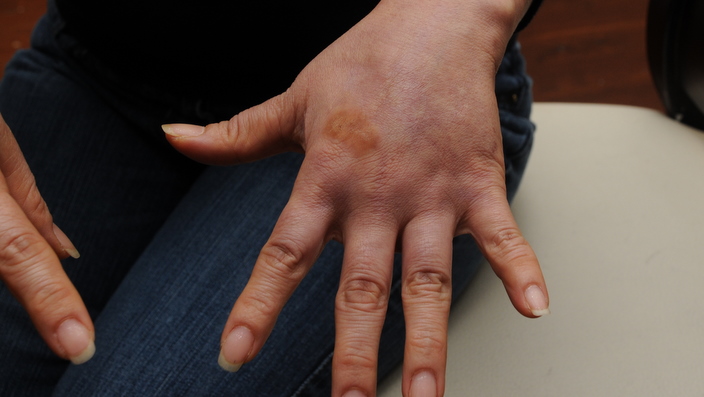 An acquaintance had introduced Mrs Lee to a Korean cosmetic surgeon who came to Australia on a tourist visa.
An acquaintance had introduced Mrs Lee to a Korean cosmetic surgeon who came to Australia on a tourist visa.

Mrs Janet Lee's hands with inflammation Source: courtesy
She received dermal filler injections into her forehead, under her eyes and in both hands at a private residence in Strathfield -- a Sydney suburb with a large Korean population.
Mrs Lee said she felt pressured by her acquaintance to get the treatment. She eventually conceded along with three other friends.
“Initially, I didn’t have the intention to get any kind of cosmetic procedure. That day one of my acquaintances told me she got one already and it looked good. Then she encouraged me to do it as well and suddenly felt like I also should have one,” Mrs Lee said.
Complications three months after the procedure
It seemed fine at the beginning.
However, after three months, both of her hands started to swell and the complications spread out to other areas where she had fillers injected.
“My face swelled massively. It was so terrible that I couldn’t even go out of my house. When I had a lump in the middle of my forehead, I really didn’t know what to do.”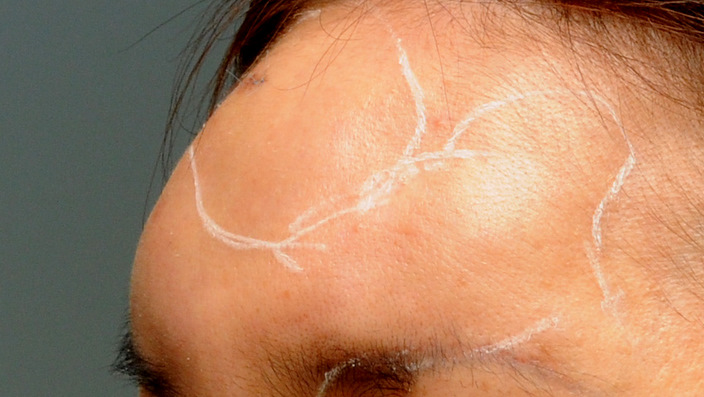 The procedure was carried out by a male Korean doctor in his 60s called "Dr Kwon".
The procedure was carried out by a male Korean doctor in his 60s called "Dr Kwon".

Mrs Janet Lee's forehead with inflammation Source: courtesy
As soon as the inflammation appeared, she contacted Dr Kwon through her acquaintance.
When she went to him with the severe swelling, it was obvious Dr Kwon was flustered and out of his depth, she said. He tried her on several treatments to try and relieve the problem, but there was no improvement.
When the time came for him to leave Sydney, Dr Kwon left the hapless Mrs Lee with a large bag of medication from Korea and the instruction to take them every day. He assured her she would be cured soon. She wasn't.
Mrs Lee took the medication for six months but the face inflammation didn't improve and she observed a new symptom: she needed to urinate much more frequently.
“I went to see a Korean GP. I showed him the medication that I was taking at the time. I was told they were a kind of steroid and when you take steroids for a long period you develop kidney problems just like me”.

Medication that Mrs Janet Lee got from so called Dr Kwon Source: SBS
"Doctor Kwon" wasn't even a doctor
Mrs Lee had been suspicious about Dr Kwon’s qualifications so undertook some research, whereupon she discovered he wasn't a doctor at all.
“I found out he worked in a cosmetic clinic in Korea when he was young but only as an administration manager [not a doctor]. Somehow he learnt the [injection] skill and started to work doing this.”
When the Australian doctor saw the amount of medication Mrs Lee was taking, he said she was lucky she hadn't overdosed.
Illegal permanent fillers found in Mrs Lee’s forehead
Desperate to fix the unsightly and painful complications from the botched procedures, Mrs Lee eventually visited a cosmetic clinic where she was given more shocking news.
“The Australian clinic conducted a biopsy on my forehead. And it was revealed that the filler in me was permanent industrial filler which is not allowed to be injected into a human body in Australia.”
Fillers used in Australia can be removed by injecting them with a substance that dissolves the filler. However, it is impossible to remove permanent filler even with the latest medical technology. The only way to treat the inflammation caused by the permanent filler is with injections that temporarily sooth the pain and swelling. These will need to given monthly for the rest of her life. While the worst area of inflammation; her forehead and under-eye, are treated every six months.
Mrs Lee's botched cosmetic surgery has also resulted in severe depression.
“Every morning I see myself through a mirror to see if there is any disfigurement. People don’t mention anything about my face but I know something is different in my face. I cannot make eye contact with people during a conversation because I feel like they are looking at my face.”
It has been eight years since the procedures but Mrs Lee feels like it is an ongoing event. She still doesn't feel comfortable talking about the decision that led to her debilitating condition.

Mrs Janet Lee's forehead with inflammation Source: SBS
'Doctor' fled back to Korea and went into hiding
When her complications became more serious, Dr Kwon told Mrs Lee his visa was expiring soon and he needed to return to Korea. He promised Mrs Lee that he would pay for Lee’s medical expenses but as soon as he was back in Korea, he changed his mobile number and Mrs Lee couldn’t contact him again.
“Finding him seemed too difficult for us because we had our own lives here. We couldn’t afford to quit our jobs and go to hunt him in Korea. In addition, he was hiding so I didn’t think there was a way to find him.”
“I paid $2,000 - $2,500 per each area treated but it only costs $700 in an Australian cosmetic clinic.”
Mrs Lee paid over $2,000 for each part of the body treated with injected fillers. She found out later that she had been ripped off.
“I paid $2,000 - $2,500 per area treated but it only costs $700 at an Australian cosmetic clinic.”
She also discovered her acquaintance, the person who introduced her to Dr Kwon, was a broker searching for patients like her.
“I did not know at the time but I think she was a broker. She seemed to get some commission from the cost that I paid to [Dr Kwon].”
https://www.youtube.com/embed/TWmineAZeIQ
Why she chose a cosmetic surgery outside a clinic
Mrs Lee knew that having a cosmetic procedure in a private house was not the right thing to do. So why did she make this dangerous choice?
“First of all, it is easy. It’s very complicated to go to a cosmetic clinic here. Most of the people having this private service are pretty old. They are normally in their 50s, 60s or even 70s," she said. "They don't plan the cosmetic procedure very much. Some people closer to them suggest them to do it and the decision is made in the moment.”
In addition, Mrs Lee said she had felt comfortable to have the medical procedure performed by a Korean practitioner because, as a migrant, her English ability was limited.
Mrs Lee was not the only one to suffer complications from her botched procedure. One of her friends who got injected fillers with Mrs Lee also had complaints. She had to pay to have her nose straightened with cosmetic surgery in Korea after the fillers where injected.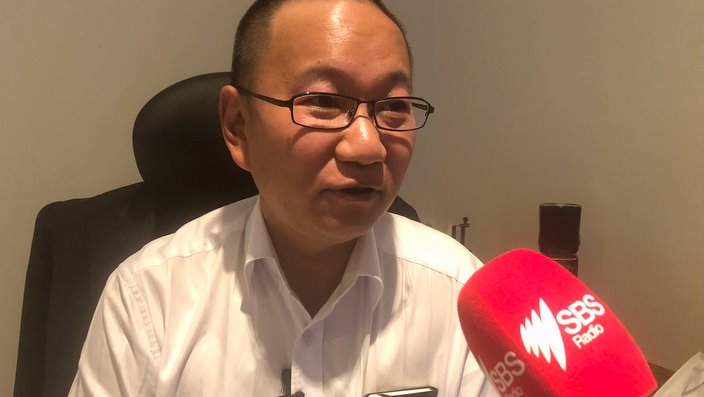

Dr Peter Kim is a Cosmetic Surgeon with a Korean background who has been practicing in Australia about 10 years. Source: SBS Korean Program
null
Illegal cosmetic procedures happens in Korean, Chinese and Vietnamese communities
Dr Peter Kim is a Korean Australian cosmetic surgeon who has been practicing in Australia for a decade.
The doctor specialises in cosmetic procedures for Asian clients. He says he sees a lot of people from migrant communities in Australia suffering the side effects of illegal cosmetic procedures.
“Being from an Asian background and specialising in Asian cosmetic procedures, I do see a fairly high number of patients who had complications using this service. There were many Korean, Chinese and Vietnamese patients with the complications", Dr Kim said.
Dr Kim sees at least two to three patients a year suffering side-effects from botched cosmetic procedures. It used to be worse a couple of years ago when he would treat at least one patient a month.
The SBS Korean program discovered that fly-in doctors from Korea still operate in Australia and they have expanded their markets to other ethnic communities such as Chinese and Vietnamese. 'Brokers', like the one who pressured Mrs Lee into her procedure, actively promote cosmetic treatments by Korean 'doctors' and recruit patients from migrant communities isolated by language barriers.
The brokers usually use the messenger program Wechat or various websites in Chinese and Vietnamese languages. They use the popularity of Korean celebrities and global fame of the advanced Korean cosmetic surgery skills.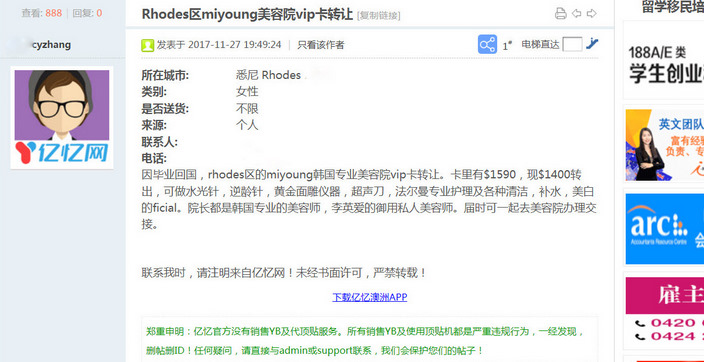

Chinese web post about Korean cosmetic surgeon Source: captured
Language barrier is a main problem
Dr Kim believes much of the success of the illegal beauty industry in Asian migrant communities can be attributed to a language barrier.
“First of all, a lot of people want to be beautiful. But I think the main problem is a language barrier because they do not seem to speak good English," he said.
"They have a fear of going into mainstream cosmetic centres to have a proper treatment. So they tend to rely on their own people who can speak the same language and end up having procedures that are often illegal. Also a pyramid scheme is often used to recruit patients.”
“It is absolutely illegal even for the best cosmetic surgeon in Korea to practice in Australia because they are not licensed here.”
Dr Kim also pointed out that clients seeking to have cosmetic work done believe the practitioners are registered doctors in Korea, with the necessary accreditation to perform procedures in private residences in Australia.
“Australian law says if you don't have an Australian qualification, you should not be practicing in Australia. It is absolutely illegal even for the best cosmetic surgeon in Korea to practice in Australia because they are not licensed here.”
Dr Kim also emphasised that if any complications arise from illegal procedures done by foreign doctors, it is hard to have a follow-up treatment.
Illegal cosmetic procedures target migrants’ vulnerability and money
People who visit Australia to practice illegal cosmetic procedures target vulnerable migrants because of a series of reasons:
- feeling comfortable to speak in their native language
- respecting and trusting advanced cosmetic procedure skills in Korea as a result of global popularity of K-Pop and K-Drama
- low risk of reporting to relevant authorities in Australia due to limited English skills
- low risk of holding foreign doctors responsible because of physical distance between two countries and the fact that busy migrants often cannot afford to go to Korea to search the doctors.
On top of these reasons, illegal cosmetic procedure is a profitable business.
“If you are not willing to let your children have illegal procedure then you really shouldn’t let somebody else do that to you either.”
Botched-surgery victim, Mrs Lee said the industry continues to be a lucrative one for operators and is still happening in secret in Australia's migrant communities.
“They make a lot of money and they won't give up. As you can see it is very expensive and they cannot make this big money back in Korea. And people here are easy so they will keep doing it as long as they can.”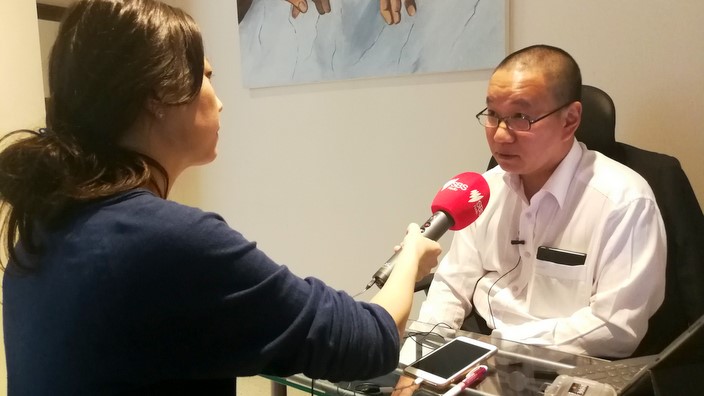 Registered cosmetic surgeon Dr Kim implored those considering illegal cosmetic procedures against engaging these services.
Registered cosmetic surgeon Dr Kim implored those considering illegal cosmetic procedures against engaging these services.

Dr Peter Kim, a Cosmetic Surgeon with a Korean background talking to SBS Korean program Source: SBS Korean Program
“Please be very careful and be very wary because it has serious complications. All medical procedures and treatments need a proper follow-up. It means they cannot provide the follow-up if you have a complication. Often they cannot be treated and if that can't be treated sometimes they cause a permanent disfigurement.”
“If you are not willing to let your children have illegal procedures then you really should not let somebody else do that to you either.”
*Name changed to protect identity
Watch another story about Illegal cosmetic procedures in Australia by the FEED
